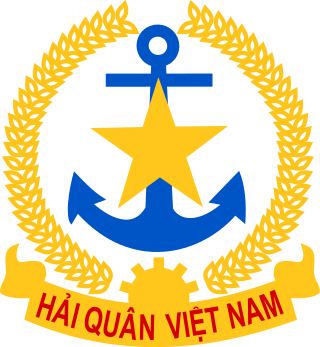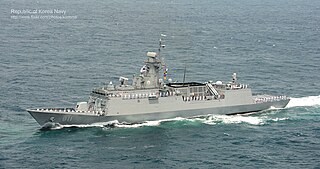
A cruise missile is a guided missile used against terrestrial or naval targets, that remains in the atmosphere and flies the major portion of its flight path at an approximately constant speed. Cruise missiles are designed to deliver a large warhead over long distances with high precision. Modern cruise missiles are capable of traveling at high subsonic, supersonic, or hypersonic speeds, are self-navigating, and are able to fly on a non-ballistic, extremely low-altitude trajectory.

The Russian Gepard-class frigates, Russian designation Project 11661, is a class of frigates that were intended as successors to the earlier Koni-class frigates and Grisha, and Parchim-class corvettes. The first unit of the class, Yastreb (Hawk), was laid down at the Zelenodol'sk Zavod shipyard at Tatarstan in 1991. She was launched in July 1993, after which she began fitting out; fitting was nearly completed by late 1995, when it was suspended due to lack of funds. Renamed Tatarstan, the ship was finally completed in July 2002, and became the flagship of the Caspian Flotilla. She has two sister ships, Albatross, and Burevestnik, which was still under construction as of 2012.
A surface-to-surface missile (SSM) or ground-to-ground missile (GGM) is a missile designed to be launched from the ground or the sea and strike targets on land or at sea. They may be fired from hand-held or vehicle mounted devices, from fixed installations, or from a ship. They are often powered by a rocket engine or sometimes fired by an explosive charge, since the launching platform is typically stationary or moving slowly. They usually have fins and/or wings for lift and stability, although hyper-velocity or short-ranged missiles may use body lift or fly a ballistic trajectory. The V-1 flying bomb was the first operational surface-to-surface missile.

The Vietnam People's Navy, or the Naval Service, also known as the Vietnamese People's Navy or simply Vietnam/Vietnamese Navy, is the naval branch of the Vietnam People's Army and is responsible for the protection of the country's national waters, islands, and interests of the maritime economy, as well as for the co-ordination of maritime police, customs service and the border defence force.

The Zvezda Kh-35 is a Soviet turbojet subsonic cruise anti-ship missile. The missile can be launched from helicopters, surface ships and coastal defence batteries with the help of a rocket booster, in which case it is known as Uran or Bal. It is designed to attack vessels up to 5,000 tonnes.

The Hyunmoo-3 is a cruise missile fielded by the South Korean military designed by Agency for Defense Development (ADD). The name Hyunmoo comes from a mythical beast described as the "Guardian of the Northern Sky", perhaps hinting North Korea.

Viettel Football Club, simply known as Viettel FC, is a Vietnamese professional football club based in Hanoi. The club belongs to the Viettel Sports Centre, a part of Viettel Group and competes in the V.League 1, the top tier of the Vietnamese football league system.

The SSM-700K C-Star (Haeseong) is a ship-launched sea-skimming surface-to-surface anti-ship cruise missile developed by the South Korean Agency for Defense Development (ADD), LIG Nex1 and the Republic of Korea Navy in 2003. The missiles are deployed on KDX-II and KDX-III destroyers as of 2006, each carrying 8 and 16 of the missiles respectively, and on Ulsan-class frigates.

The Incheon-class frigates, also known as the Future Frigate eXperimental or FFX during development, are coastal defense frigates of the Republic of Korea Navy. The lead ship was launched on 29 April 2011. The Incheon-class frigates will replace the aging fleet of Pohang-class corvettes and Ulsan-class frigates, and take over multi-role operations such as coast patrol, anti-submarine warfare and transport support. Later batches are planned to be specialized on anti-air and anti-submarine warfare. An improved version is being introduced as the Daegu-class frigate; this was previously known as Batch II of the Incheon class.

Đinh Tiên Hoàng (HQ-011) is the first Gepard-class frigate (Gepard 3.9 type) in the Vietnam People's Navy. The VPN contracted the Zelenodolsk shipyard in Russia to build the ship.
Vietnam Naval Academy is one of Vietnamese military academies belongs to Vietnam People's Navy for training naval commanding officers in division level and commanding staffs in tactical/campaign level, include undergraduates and postgraduates of military.
The Daegu-class frigate is a class of guided missile frigates of the Republic of Korea Navy (ROKN). The Daegu class is based on the preceding Incheon class, and has otherwise been referred to as the Incheon class batch II, or FFG-II. Eight Daegu-class ships are planned, with the final goal of 20–22 frigates in the ROKN. The Daegu-class frigates are to be built by Daewoo Shipbuilding & Marine Engineering (DSME) and Hyundai Heavy Industries.

R-360 Neptune is a Ukrainian subsonic cruise missile with all-weather capabilities developed by the Luch Design Bureau in Kyiv. Originally designed as an anti-ship missile, an alternative model was fielded in 2023 with a new guidance system to support land-attack roles. With a range of over 200 kilometres, it is intended to neutralize naval targets up to 9,000 tonnes.

ATMACA (Accipiter) is an all weather, long range, precision strike, anti-ship cruise missile, developed by Turkish missile manufacturer ROKETSAN. The Atmaca will enter service with the Turkish Navy to gradually replace the country's existing inventory of Harpoon missiles.
Yết Kiêu is a multipurpose submarine search-and-rescue ship (MSSARS) of the Vietnam People's Navy. The ship is stationed at the Vietnamese Cam Ranh Naval Base, and it is purposed to support the operation of VPN's fleet of six Kilo-class diesel-electric attack submarines which were formally acquired in 2009 and firstly commissioned in early 2014.
Sea Breaker is a fifth generation precision-guided, autonomous, long-range anti ship and land attack missile system. It is being designed and developed by Rafael Advanced Defence Systems. It can be launched from either ships or land. The air launched version of this missile is known as Ice Breaker.














